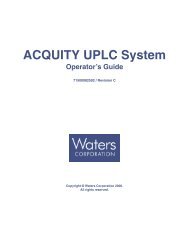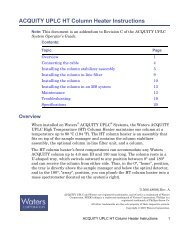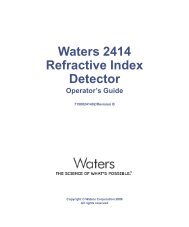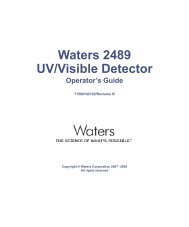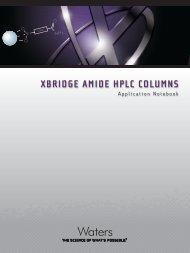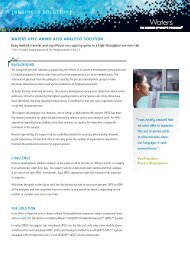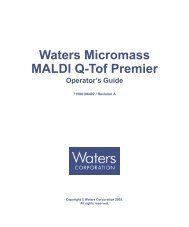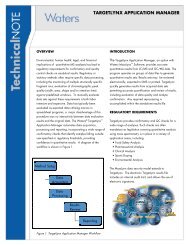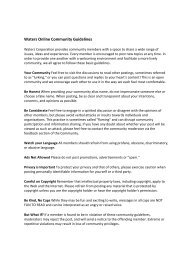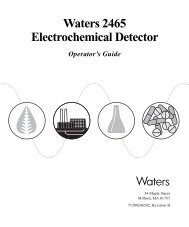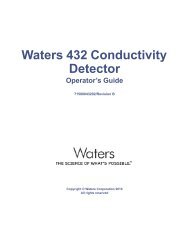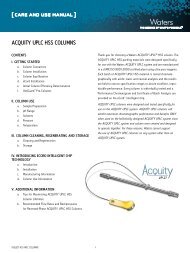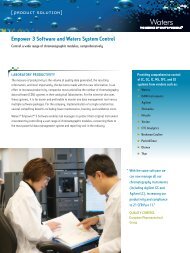Quattro 2 User's Guide, issue 2. 6666533 - Waters
Quattro 2 User's Guide, issue 2. 6666533 - Waters
Quattro 2 User's Guide, issue 2. 6666533 - Waters
Create successful ePaper yourself
Turn your PDF publications into a flip-book with our unique Google optimized e-Paper software.
<strong>Quattro</strong> II<br />
<strong>User's</strong> <strong>Guide</strong><br />
Ionisation Techniques<br />
Electrospray<br />
Electrospray mass spectrometry (ESMS) allows very large and very labile molecules<br />
to be analysed routinely. The sample, in solution, emerges from a high voltage<br />
capillary tube into a strong electrostatic field at atmospheric pressure producing an<br />
aerosol of highly charged droplets. Evaporation of solvent from these droplets results<br />
in sample ions. In the case of proteins and other biomolecules, such ions may carry<br />
several electronic charges.<br />
Electrospray is compatible with on-line HPLC and capillary electrophoresis but is<br />
restricted to polar samples.<br />
Atmospheric Pressure Chemical Ionisation<br />
Atmospheric pressure chemical ionisation (APcI) is a soft ionisation technique able to<br />
accept the entire eluent from a standard 4.6mm diameter HPLC column.<br />
Sample droplets are vaporised in a heated chamber before emerging into a region of<br />
solvent ions formed within the atmospheric pressure source by a corona discharge.<br />
Ionisation occurs as a result of chemical reactions between the sample molecules and<br />
solvent ions.<br />
The Combined EI/CI Source<br />
Most <strong>Quattro</strong> II systems are equipped with a combined source capable of operating in<br />
both the electron impact (EI) and chemical ionisation (CI) modes. In either mode, the<br />
source may be used in conjunction with the reference inlet, the insertion probe, the<br />
GC inlets or the particle beam interface.<br />
Electron Impact<br />
Electron impact is the classical ionisation technique in which gas phase sample<br />
molecules are ionised in collisions with high energy electrons. The source is heated to<br />
ensure sample vaporisation.<br />
Chemical Ionisation<br />
When the combined EI/CI source is operated in the chemical ionisation mode, a<br />
reagent gas is admitted to the source at a relatively high pressure. The gas molecules<br />
are ionised by the electron beam. Sample ions are generated in reactions with these<br />
gas ions. CI is a “softer” ionisation technique than EI, producing less sample<br />
fragmentation and generally a stronger molecular ion.<br />
Desorption Chemical Ionisation<br />
Polar samples, liable to decomposition under normal CI conditions, are deposited on<br />
the tip of the DCI probe and thermally desorbed into a CI environment.<br />
Instrument Description<br />
Page 14



![[ TIPS ] [ ACQUITY UPLC SYSTem QUICk START CARD ] - Waters](https://img.yumpu.com/51427825/1/190x245/-tips-acquity-uplc-system-quick-start-card-waters.jpg?quality=85)
